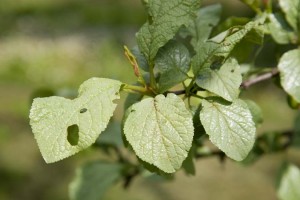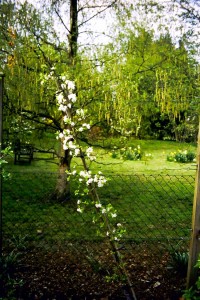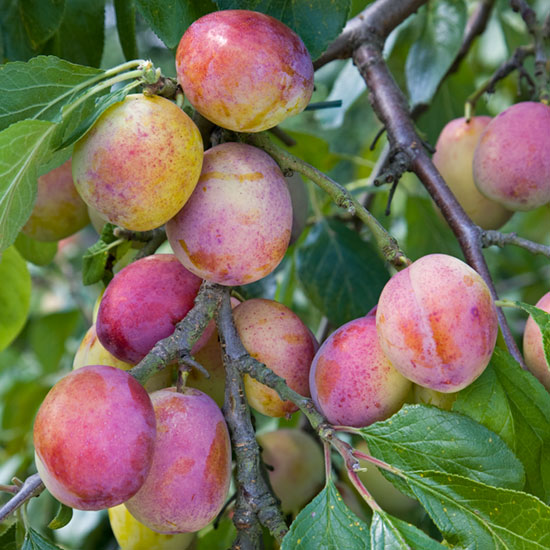Many gardeners who grow their apples and pears as cordons have often contemplated whether they can grow stone fruits in a similar way. Books and “experts” often say that this cannot be done – or at least very well – as stone fruits can only do well when grown as bushes or fans; I beg to differ! I have experimented growing all stone fruits as cordons!
Stone fruits need to be considered in three groups when deciding whether to grow them as cordons. The first group contains plums, damsons and gages which are easy to grow as cordons as fruit will grow on both last year’s growth and previous years’ growth and there is generally little dieback to contend with. Definitely grow these as cordons! The second group contains apricots, peaches and nectarines which primarily fruit on last year’s growth and this wood can be very prone to winter dieback. This can often result in the whole stem of a cordon dying back which means that the whole process will have to be started again. My advice is to not grow these as cordons but as fans against walls or fences or as dwarf bushes in pots. The third group contains cherries although I would exclude the sour cherry ‘Morello’. Cherries can grow quite well as cordons although perhaps not as easily as plums, damsons and gages. Whilst cherries will fruit on both last year’s growth and previous years’ growth it is possible that dieback can occur on occasions on 2 year old plus wood so I suggest that you might like to experiment with cherries but accept that they might not be as successful as plums. If you don’t want to chance a cherry as a cordon I suggest that you grow it as a fan against a wall or fence.
The purpose of this blog is to show that plums, damsons and gages can be grown relatively easily and productively as cordons and that this method of growing is perhaps the best way for the gardener with the small garden. For the purposes of this article whenever I refer to plums I also include damsons and gages. You can also use the same growing rules for cherries if you are looking to experiment.
First of all let me explain why I initially considered growing plums as cordons. Back in the early 1980’s when I was undertaking a considerable amount of planting of apples and pears I decided to plant up a number of plum trees. However, as I was planting all of my apples and pears as cordons it would prove difficult to incorporate bush trees. In any case these trees would take up a considerable amount of space, perhaps enough room to plant three times as many cordons! Thus I started thinking of planting the plums as cordons. I was aware that the French in the Eighteenth and Nineteenth Centuries had experimented with many forms of fruit tree growing (and typical examples can be seen in the Hatton Fruit Garden at Bradbourne House, East Malling) and delving into various text books I discovered that plums were amongst those fruits they experimented with. In those days they must have grown their fruit on fairly vigorous rootstocks which must have made life very difficult when dealing with trained fruit trees. I therefore figured with the more dwarfing rootstocks that we have available now, the growing of plums as cordons should be a relatively easy task.
Whilst undertaking my research I was interested to note that Bonham Bazeley, then owner of Highfield Nurseries, was also experimenting with plum cordons and mentioned them in his 1985 catalogue. I found it gratifying to know that a leading horticulturist was also undertaking similar research as myself!
I planted my first plum cordons in 1985, the first three being ‘Marjories Seedling’, ‘Kirkes’ Blue’ (subsequently discovered to be ‘Old Greengage’) and ‘Giant Prune’. I chose these three varieties because they are relatively short jointed and this seemed to be a sensible way to start. During the first growing season of 1986 I did not allow the trees to flower and they quickly established themselves and grew well. I noticed that the growth was more vigorous than that of my cordon apples and pears and this meant that I would probably not be able to undertake one summer prune as with the aforementioned kinds of fruit but on a more regular basis so as to deal with the more vigorous growth. I found that pinching back all growth to one bud every three to four weeks during the growing season kept the trees to a relatively well trained shape. In order to prevent the ingress of disease, such as Silver Leaf, I made sure that I did not undertake any pinching out after the end of September and so far this precaution has been successful for out of the ten cordon plums that I now grow none has suffered any disease.

Silver Leaf infects the wood through wounds and causes silvering of the leaf followed by death of the branch.
In the Spring of 1987 these three trees flowered for the first time and to my utter amazement each tree was completely covered with flower: in fact it was practically impossible to see any of each tree but the flowers. What a bonus! As plums generally flower early to ensure that no frost would damage blossom I covered the trees every night and this paid off because before long each tree was covered with a large amount of fruitlets. Not wishing to overload the trees in their first year of fruiting but wishing to experiment at the same time, I thinned two of them but left the ‘Giant Prune’ unthinned.
As the summer of 1987 was hot I regularly irrigated the trees to ensure that the lack of water would not stress the trees with the resultant rejection of much of the fruit they were carrying, something which I find plums to be particularly susceptible. All three trees continued to carry and produce a good crop with the fruit size being very good, even the Giant Prune which had been left unthinned. So far the experiment was proving to be very successful and therefore I resolved to plant further plum cordons.
Thus the winter of 1987 saw me planting ‘Edwards Seedling’, ‘Denniston’s Superb’, ‘Oullins Golden Gage’, ‘Shropshire Prune Damson’ and ‘Victoria’ giving me a total of eight plum cordons. My experience with this further planting was similar to the original planting – trees which produced a good crop of well sized fruits early in their life. This was followed by a further planting of ‘Cambridge Gage’ and ‘Czar’ a couple of years ago. All of my plum cordons are still growing well and when the frost allows they produce good crops with the original trees showing no signs of reduced vigour.
To emphasise the ease of growing plum cordons I must explain that they receive no special treatment. As an organic grower I do not spray any of my fruit and in the case of the plums the only pest deterrent is the use of Plum Fruit Moth traps which trap the male moths in the same way as Codling Moth traps are used by apple growers to trap male codling moths. The plum cordons (as well as the rest of my top fruit) receive a large handful of blood fish and bone every February and that is all.
As growing plums in this way is so easy it is hard to understand why this form of cordon growing has not been widely publicised by the horticultural press. I find this a difficult question as there do not appear to be many disadvantages in growing this way; the advantages surely outweighing the disadvantages. Having grown plum cordons for years now – and advised many gardeners to do the same – I feel relatively qualified to contemplate this method of growing and as a result there are now a number of gardeners growing their plums in this way.
To me the advantages are considerable and simple – a large number of plum varieties can be grown in a small garden (my trees are planted three feet apart in London Clay), the trees come into production at an early stage, they are very attractive to look at when in flower and they produce regular crops of good size fruit. The disadvantages are few – due to their weaker growth they are not so attractive to look at when dormant (hardly a major disadvantage!) and they need regular pinching out rather than an annual prune which to many people is a distinct advantage!
I hope that this short blog has proved of some interest and I thoroughly recommend that you try growing plums in this way. In fact you might actually find this method of growing to be very successful!
Gerry Edwards
11th March 2013
Gerry is an experienced amateur fruit grower who is Chairman of the RHS Fruit Group, a member of the Royal Horticultural Society’s Fruit, Vegetable and Herb Committee and also their Fruit Trials Panel. Gerry judges fruit nationally for the Royal Horticultural Society and is also a qualified National Vegetable Society judge.



Brilliant! Just what I wanted to hear!! I had been told that it wasn’t possible to grow plums, etc. as cordons and was discouraged from doing it. I’m not permitted to grow free standing fruit trees on my allotment (for very understandable reasons) but there does not seem to be a problem with step overs and cordons.
What is a ‘cordon’?
Cordons are columnar fruit trees that crop on short side branches on a single stem. They are ideal for small gardens as they can be planted as close as 2-3ft apart (we recommend a minimum of 3ft for stone fruits). Traditionally cordons were grown at a 45 degree angle and supported by posts and wires or trained against a wall. The modern way to grow them is to plant them vertically and use a stake to support them.
This was a refreshing read! I too have disputed the accepted wisdom that cordons are only suitable for apples and pears… although I must admit to having 15 stone fruits in the early stages of fan training at present. I do have one Victoria plum trained as a double cordon (vertical rather than oblique) – it is loaded with fruit buds this year, so I am hopeful of a generous harvest, weather permitting.
You might be interested in an old text entitled ‘Cordon Training of Fruit Trees’ by Rev. T Collings Brehaut, published in 1860, which advocates such training for a variety of fruits – including peaches – although in this case a system of spurs is developed from which a pair of short shoots are grown each year, one side being removed alternately to provide the necessary supply of second year fruiting wood.
reading about highfield nurseries it was whilst i was living in the highlands of scotland i got all my fruit tree’s there but then joyce’s husband either retired or passed on they now only have the garden shop and having only a small garden cordon or pillarettes ideal for small spaces main factor is the moth traps for apples and plums i make my own using treacle water and yeast wasps also go for fruit so use a small plastic milk container with holes put in water and 2 tablespoons of white sugar wasps love it
Could you comment on whether there is any advantage or disadvantage growing plum etc;cordons at an angle?
You can grow cordons vertically or at a 45 degree angle. They do tend to be slightly heavier cropping when grown at an angle as this slows down the vigour of the tree.